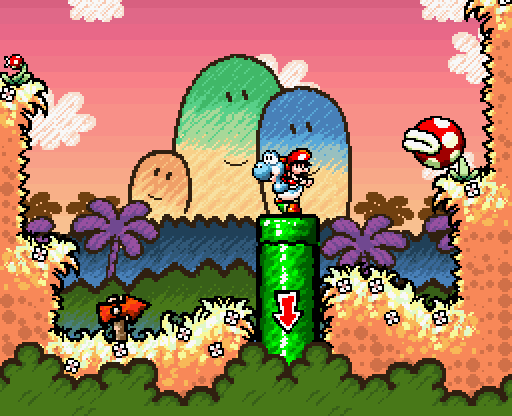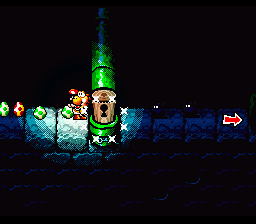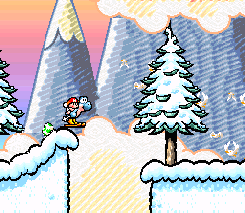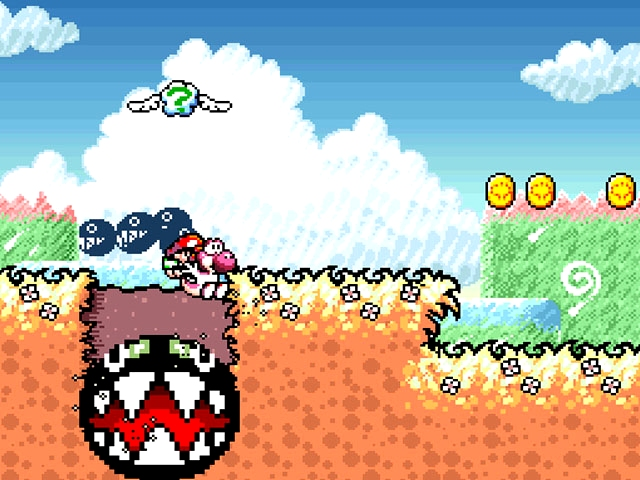Yoshi’s Island is by all means a spectacular achievement that still plays as well as it did when it was released and that retains its capacity to amaze; moreover, it is a considerable statement on how sequels can break into completely new ground
It is hard to find a sequel that is as different from its predecessor as Super Mario World 2: Yoshi’s Island. After forging a title that has, even after many years, remained as one of the prime examples of the glory of sidescrolling platformers, Nintendo could have easily phoned it in and constructed Super Mario World 2 over the bones of the instant classic that was Super Mario World. Gamers would have rejoiced, the company would have saved a great deal of resources and effort, and although such a fictional game would have certainly had a hard time moving out of the shadow of its older sibling, it is highly likely it would have been warmly received and critically praised.
Instead, Nintendo took the opposite path, the one less traveled, and opted to create a game with such astoundingly unique traits that it ended up birthing, from within the main line of Mario platformers, a completely different series that would go on to have an illustrious and long life of its own.

There are, of course, some similarities between Super Mario World and Yoshi’s Island. Both, after all, are set in the Mushroom Kingdom, have the shape of 2-D platformers where the goal is to navigate levels grouped into worlds in order to get to a final castle, and star Mario and Yoshi taking on an epic journey as they attempt to settle the score with the Koopa clan.
There is, however, a far larger number of significant distinctions between the titles. And these permeate absolutely everything: from the storytelling, which gains a more prominent role, to the gameplay itself, which floats away from the straightforward obstacle courses of Super Mario World and veers into terrain that is far more intricate; and including the compositional style of the soundtrack, which abandons the frantic and energetic spirit of Super Mario World for far more relaxing and soothing melodies, as well as the visuals with which the game presents its rather colorful and cute tale.
Out of all those shifts, the one that is unquestionably the most noticeable – not only because it can be seen on every image of the game, but also because it is the first aspect gamers will come into contact with once they turn the software on – is found in the art style. Born out of Miyamoto’s desire to produce a 2-D game that would visually stun and take the Super Nintendo’s hardware to its limit while avoiding leaning on the pre-rendered graphics of the Donkey Kong Country saga (which he disliked), Yoshi’s Island was graced with an extremely cartoonish look that gives off the unshakable feeling that its lines were brought to life by an astonishingly talented child with a box of crayons.
It features a brightness, colorfulness, and vividness that most of its contemporaries could not even dream of; furthermore, it oozes artistic originality, as all of its assets (including character models, enemies, and backgrounds) have very unique touches, even if – as it is the case of Yoshis, Goombas, Koopas, and others – they had already appeared on previous Mario games.

The highlights of the visual department, though, are certainly the scenarios and backgrounds. The latter group, in particular, could be easily (without exception) framed and hanged on the walls of any art gallery without posing any sort of offense to all other works being displayed; from the crayon version of traditional Mario scenarios, like caves and jungles, to some more abstract or impressionist pieces, Yoshi’s Island has got it all and it visually excels at all times.
To make matters even more impressive, these backgrounds are adorned with elements that are animated in a very distinct way; while characters and enemies move with the required flow, the animation of minor objects is more abrupt, as if a few frames were purposely removed. Instead of giving the graphics a clunky aura, though, this absolutely calculated animation style serves to augment the feeling children’s hands were involved in the confection of what is seen, giving birth to scenario compositions that are bound to leave one speechless.
This spirit of infancy that is prevalent in Yoshi’s Island goes hand in hand with its plot, for although numerically the game is the sequel to Super Mario World, in timeline terms it works as its prequel. Here, Mario and Luigi are babies being carried to their parents by a stork. Somewhere along the way, sadly, Kamek – who for some reason is aware the babies will, in the future, pose a threat to the Koopas – attacks the bird and flies off with a kidnapped Luigi while Mario falls to his doom. As luck would have it, though, Mario lands precisely on Yoshi’s Island and, even more impressively, right on the back of a Yoshi, who takes it upon itself – alongside the other members of its tribe – to carry Mario all the way to Bowser’s Castle, where Luigi is being kept. Super Mario World 2, therefore, carries a plot that is far more developed than the one from its predecessor.
By taking advantage of its colorful kid-friendly presentation, the game is embedded with a storybook charm. Not only is its tale told through a relatively long cutscene that opens the game accompanied by a lovely tune that seems to pour out of a music box, but dialogues – which occur whenever Kamek appears to unleash a boss upon Baby Mario and Yoshi – also take place.
Similarly to its graphics, the gameplay of Yoshi’s Island emerged from a personal beef held by Miyamoto. In this case, his distaste came from how Yoshi – a character who had debuted to amazing popularity and success in Super Mario World – was subsequently given the chance to star alone in games only to have them turn out to be considerably lackluster, a label that easily applied to Yoshi’s Safari and Yoshi’s Cookie. Looking to give the colorful breed of friendly dinosaurs an adventure worthy of the love they received from the fan base, Miyamoto and the team at Nintendo EAD certainly achieved that with Super Mario World 2: a game that takes full advantage of Yoshi’s wide and varied set of abilities, which are employed in various ways as he navigates the forty-eight levels that are organized into six worlds.

Besides the basic moving and jumping, Yoshi can launch his tongue to swallow enemies with the Y button; turn them into eggs by pressing downwards when they are in his mouth or just spit them out by repressing the same button; and, by pressing A, use eggs as projectiles to shoot at pretty much everything, including other foes, some stage hazards, breakable objects, and collectibles. In addition, Yoshi can execute his signature flutter jump by holding onto the B button to remain in the air for a while longer as well as to gain some altitude. The controls are extremely responsive, and the aiming mechanic – which had the potential to be troublesome – is handled quite smoothly.
When the A button is pressed and the throwing action is triggered, Yoshi holds onto the egg and a reticule starts automatically moving around the character. All players have to do is press A again at the right time to launch it in the correct direction or press down to cancel the throw. Given aiming is done automatically, whenever Yoshi is set and the reticule is moving the D-pad as well as most of the other buttons remain free, which allows the character to move and jump while aiming, a precious gift to some of the game’s more action packed sequences or during times when players want to act quickly.
What Nintendo does in Yoshi’s Island is proceed to take advantage of that distinct set of abilities to craft a gameplay experience that is also very different from that of Super Mario World. Where that game was a frequently fast rush to the end as Mario tried to escape everything the Koopas threw at him, Yoshi’s Island moves at a far slower pace. Even though there are plenty of platforms and bottomless pits, it is not about jumping; and even though there are large hordes of enemies out to take down Yoshi and Baby Mario, it is not about beating them down or avoiding them altogether.
Yoshi’s Island often asks for a kind of sidecrolling progression that is more meticulous; its levels are far less linear than those of Super Mario World, frequently offering alternate paths, numerous secret locations with different rewards, key-finding puzzles, optional transformations that have Yoshi turning into a digging machines, a helicopter, and others, and sometimes even dabbling into the kind of backtracking that on Super Mario World would be reserved exclusively to ghost houses and castles.
That is not to say Super Mario World 2 is complex or harder to get into than its predecessor; if one wants to simply get to the end of its stages, they will encounter a level of challenge that is navigable to youngsters (even if it does demand an extra level of attention) and pleasant to adults. Additionally, they will come into touch with a unique brand of level design that, here, is at its very peak, as all stages are carefully constructed courses that smartly make use of one or more creative ideas. Those who wish to go further, though, will have to come prepared, for Yoshi’s Island is ready to mercilessly throw the total extent of its difficulty and complexity at them, as fully completing the game is a task easily comparable to – and perhaps even mentally tougher than – achieving the legendary 100% completion in Super Mario World.

The balancing of difficulty and accessibility done by Yoshi’s Island starts with the fact that, in this particular adventure, dying is somewhat harder than in a regular platformer and the losing of progress upon getting a game over is minimal. Firstly, there is no such thing as a health bar; Yoshi is, by all means, an immortal creature that only falls to deadly spikes, lava, or bottomless pits.
The main source of his downfall is that whenever he is hit, a countdown will be triggered and Baby Mario will start floating around in a bubble while emitting the most annoying sound effect in gaming history (a baby’s cry). If players are unable to recover the baby before the clock ticks down to zero, Kamek’s army – called by the racket – will swoop in, take the baby away, and Yoshi will lose a life and have to restart from the checkpoint that was last activated. Secondly, if players run out of lives, instead of having to start from the last save point, as it was the case in Super Mario World, they merely have to go back to the beginning of the level they are in.
There is, consequently, plenty of room for error. The countdown, which begins all levels at ten, always regenerates back to that number when the baby is brought back to Yoshi’s back. Furthermore, by collecting stars, which are not that uncommon and can usually be found inside crates or floating clouds that can be hit with eggs, players are able to take the clock all the way up to thirty (stars found when the clock is at its maximum will become coins). Most of the times, this mechanic that involves rescuing the baby works wonders and adds a lot of personality (and action) to Yoshi’s Island; unfortunately, there are some absolutely infuriating occasions when Baby Mario floats to regions that are too high to be reached or that are just too complicated to get to, which makes the countdown drain shockingly fast and players lose their patience over what will seem like being doomed by poor luck or unpolished programming.
The real challenge of Yoshi’s Island, and much of its extra difficulty, complexity, and need for meticulous exploration, lies in its collectibles. Where in Super Mario World the many secret exits were the sole extra piece of content the game carried, its sequel greatly expands upon it by hiding, in every level, five flowers and twenty red coins (essentially regular golden coins with a barely noticeable reddish hue and that reveal themselves to be red when touched). By being summed with the number that is on the countdown as players finish the stage, these items amount to a final score that can be as great as 100. Through those means, Super Mario World 2 creates an experience that leans quite strongly towards item collection and combing levels for all their secrets, hidden caves, bonus rooms, and others; so much, in fact, that there is no clock whatsoever controlling how much time players can spend on a stage.

By not accumulating collected items for subsequent playthroughs of levels and by taking the countdown into consideration when calculating the score, the full completion of Yoshi’s Island essentially demands that players execute nearly flawless runs through every stage, collecting everything in sight while avoiding as many hits as possible. It is a brutal task and one that can be anger-inducing due to how some items are permanently missable, with Fly Guys that fly away carrying red coins being the clearest example of that design shortcoming.
The ordeal, however, does have its rewards. All worlds have a secret level, of especially high difficulty and usually marvelous creativity, and a bonus mini-game that can yield lives as well as items that can be used mid-stage for assistance; and these are unlocked by getting perfect scores on all eight levels of a world. In addition, upon completing a secret level, a star is added to the title screen, an award that will certainly appeal to perfectionists or those who want to have their platforming skills tested.
The final highlight of Yoshi’s Island, and an area in which it clearly surpasses Super Mario World, comes in the form of its bosses. As all worlds feature a fort and a castle, each culminating with a big bad guy to be fought (which is essentially just a regular enemy made into a giant by Kamek’s magic), Yoshi’s Island packs a whopping sixteen bosses of completely different natures, attack patterns, and weaknesses.
Truth be told, none of them are especially hard (which is a gift to those who want to seek full completion and will have to avoid being hit by them to have their countdowns preserved), but not only are they very fun to play, but they also provide plenty of visual variety and gameplay surprises. When compared to the repetitive boss encounters of its predecessor, the cast of bosses of Super Mario World 2 is a major leap forward and one that, for some reason, has not been replicated in the same scale and quality by other sidescrollers of the main Mario series, which speaks volumes about how great these battles are while also saying a little about Nintendo’s underwhelming performance in that particular area.
It is pretty obvious, from everything it does, that a spectacular amount of work, dedication, and creativity went into the making of Super Mario World 2: Yoshi’s Island. Its addition of collectibles and its focus on more intricate levels showed the Mario 2-D games had the capacity to be far more than a straightforward race to the finish, and its artistic prowess created a visual masterpiece that succeeded in topping even the graphics of games that took the hardware of the era to the edge of their technical limits. It is true it carries some easily avoidable design issues that end up being the cause of some frustration, and it is arguable some of its worlds could have benefited from more of a thematic cohesion between levels, as sometimes it feels like backgrounds are used randomly rather than to form a uniform theme. Nonetheless, Yoshi’s Island is by all means a spectacular achievement that still plays as well as it did when it was released and that retains its capacity to amaze. And those are the biggest statements that can be made about the brilliancy of the content within.

Awesome review! This is one of those special childhood games for me. I actually learned to read because I wanted to know what Kamek was saying, haha. Also, the Bowser battle at the end of the game was amazing. The music was fantastic!
That battle is among the best ones ever. It’s simply sensational!
And that is pretty cool story. It goes to show the power of videogames. =D
That’s funniest looking 9 or 10 I’ve ever seen.
hahahahahahahaha
It is indeed quite funny looking.
Seriously though, this game is sooo good. One of the best platforms ever (I actually like it better than SMB3, but I don’t know about World). I can understand some of your complaints, such as the one-shot opportunities, but seeing as you can replay the levels, I don’t think it’s too bad of an issue. Also, I thought I heard recently that Miyamoto’s disliking of DKC wasn’t true, and that he was taken out of context. That he liked the games, but didn’t like being told to make his games more like them (if I could claim to have made Mario AND Zelda, I guess I wouldn’t want people telling me how to do my job, either).
Yeah, the one-shot opportunities annoy me quite a bit.
I had never heard about the whole Miyamoto disliking DKC thing was taken out of context. It is quite possible, but I also wouldn’t be surprised if he did not, because he does have some pretty odd opinions sometimes, such as wanting to diminish the role of a story on Paper Mario games and thinking F-Zero GX was not any good.
But yeah, if I had created Mario and Zelda I certainly would not like people telling me what to do. I have not done any of that and I already hate it. =P
And I like SMB3 and World better than Yoshi’s Island even if both also have their minor annoyances. I guess I enjoy their faster pace more.
One of my all time favourite games still. I prefer this to Super Mario World, actually. Mega!
Awesome! I prefer Super Mario World, but you can’t really go wrong with any. They are two major classics.
How dare you! A flame war is required on matters of difference in any gaming debate. Have at you, sir!
But, yes, they are both tremendous.
hahahahahahahahahaha
Disagreements such as those can always be settled via punching, kicking, and other sorts of physical violence, as long as it is on a Super Smash Bros match.
Great review!! This is one of my all- time favorite games. I’ve played through it so many times and it never gets old… well, except for when baby Mario cries! THAT was such an annoying sound, haha!
It’s absolutely annoying! I am glad to hear someone who is as big of a fan of that game as you enjoyed the review. Thanks!